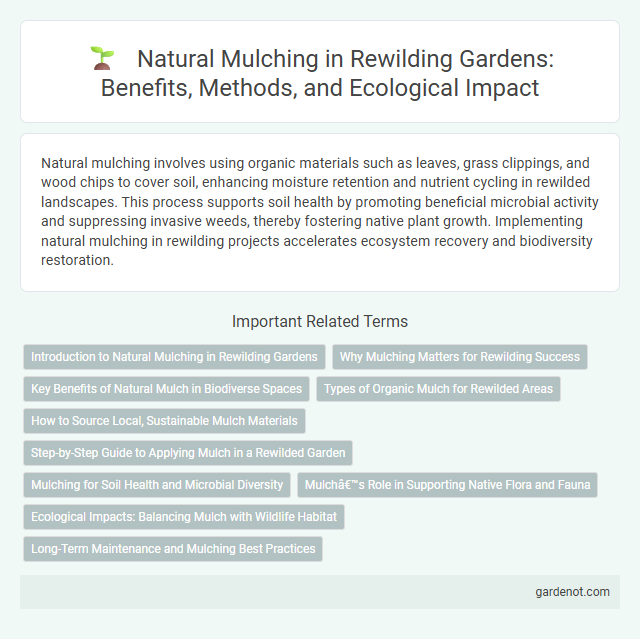Natural mulching involves using organic materials such as leaves, grass clippings, and wood chips to cover soil, enhancing moisture retention and nutrient cycling in rewilded landscapes. This process supports soil health by promoting beneficial microbial activity and suppressing invasive weeds, thereby fostering native plant growth. Implementing natural mulching in rewilding projects accelerates ecosystem recovery and biodiversity restoration.
Introduction to Natural Mulching in Rewilding Gardens
Natural mulching in rewilding gardens enhances soil health by retaining moisture and suppressing weeds without synthetic chemicals. Organic materials like leaf litter, wood chips, and straw decompose gradually, enriching soil biodiversity and promoting native plant growth. This sustainable practice supports ecosystem resilience and encourages a balanced habitat for pollinators and soil microbes.
Why Mulching Matters for Rewilding Success
Natural mulching improves soil health by enhancing moisture retention, regulating temperature, and suppressing invasive weeds, which supports native plant growth critical for rewilding. The organic matter from mulch decomposes to enrich soil fertility, fostering biodiversity and enabling ecosystem restoration. Healthy soil ecosystems created through mulching accelerate habitat recovery, making it a vital practice for sustainable rewilding success.
Key Benefits of Natural Mulch in Biodiverse Spaces
Natural mulch enhances soil moisture retention, creating a stable microenvironment that supports diverse plant species and promotes microbial activity essential for ecosystem health. It suppresses invasive weeds, allowing native flora to thrive and increasing habitat complexity that benefits insect and animal populations. By gradually decomposing, natural mulch enriches soil fertility with organic matter, fostering a resilient and balanced biodiverse space.
Types of Organic Mulch for Rewilded Areas
Organic mulches used in rewilded areas include leaf litter, wood chips, straw, and compost, each contributing essential nutrients and moisture retention to the soil. Leaf litter mimics natural forest floors, promoting microbial activity, while wood chips help suppress invasive weeds and enhance soil structure. Straw and compost accelerate nutrient recycling, supporting native plant growth and biodiversity restoration in rewilding projects.
How to Source Local, Sustainable Mulch Materials
Sourcing local, sustainable mulch materials for natural mulching involves identifying native organic matter such as fallen leaves, grass clippings, and wood chips from pruned branches, which decompose slowly and enrich soil health. Collaborate with nearby forestry operations or community gardens to obtain wood chips and plant residues that are free from pesticides and invasive species. Prioritize mulch that supports local biodiversity by avoiding chemically treated or non-native materials, ensuring a balanced ecosystem for rewilding projects.
Step-by-Step Guide to Applying Mulch in a Rewilded Garden
Apply natural mulch by first clearing the area of weeds and debris to promote healthy soil contact. Spread a 2-4 inch layer of organic materials such as shredded leaves, bark, or straw evenly around plants, avoiding direct contact with stems. Regularly monitor and replenish mulch to maintain moisture retention, suppress weeds, and support biodiversity in the rewilded garden.
Mulching for Soil Health and Microbial Diversity
Natural mulching enhances soil health by retaining moisture, regulating temperature, and preventing erosion, which creates an ideal environment for microbial activity. Organic mulches such as leaf litter, compost, and wood chips provide a continuous supply of nutrients that support diverse microbial populations crucial for nutrient cycling. Increased microbial diversity improves soil structure, nutrient availability, and plant resilience, making mulching an essential practice in rewilding ecosystems.
Mulch’s Role in Supporting Native Flora and Fauna
Natural mulching enhances soil health by providing a protective layer that retains moisture, suppresses invasive weeds, and enriches nutrient cycling, creating an optimal environment for native flora to thrive. This organic cover supports diverse microhabitats, fostering populations of beneficial insects, earthworms, and microorganisms essential for ecosystem balance. By mimicking natural forest floor processes, mulch sustains native plant regeneration and attracts fauna that depend on healthy vegetation, reinforcing biodiversity within rewilded landscapes.
Ecological Impacts: Balancing Mulch with Wildlife Habitat
Natural mulching enhances soil health by improving moisture retention and nutrient cycling, which supports diverse plant communities essential for rewilding efforts. Balancing mulch layers is critical to avoid disrupting ground-nesting insects and small mammals, ensuring habitat structure remains intact for various wildlife species. Integrating organic mulch sources like leaf litter and wood chips promotes microhabitat complexity while sustaining ecological processes in rewilded landscapes.
Long-Term Maintenance and Mulching Best Practices
Natural mulching enhances soil health and moisture retention by decomposing slowly, providing sustained nutrient release essential for rewilding projects. Long-term maintenance involves regular replenishment with organic materials like leaves, wood chips, and untreated straw to prevent soil erosion and suppress invasive weeds. Mulching best practices emphasize maintaining a consistent layer thickness of 2-4 inches and avoiding mulch contact with plant stems to reduce pest risk and promote healthy root growth.
Natural mulching Infographic

 gardenot.com
gardenot.com